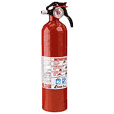|
tech
Fire
Extinguisher

Fire extinguishers come in a
variety of sizes and functions. Extinguishers are
usually rated for the kind of fire they should be used on.
In some countries fire extinguishers are colored to match
the classification, in the US there is no formal standard
but most are usually red except for class D which are
usually yellow. Extinguishers are marked with
symbols to indicate the types of fires the extinguisher is
approved for.
Below is a chart displaying the
class, symbol, pictogram, and intended use of an
extinguisher.
| Class |
Geometric Symbol |
Pictogram |
Intended Use |
| A |
Green Triangle |
Garbage can and wood
pile burning |
Ordinary
combustibles |
| B |
Red Square |
Gasoline can with a
burning puddle |
Flammable liquids |
| C |
Blue Circle |
Electric plug with a
burning outlet |
Energized electrical
equipment |
| D |
Yellow Star |
N/A |
Combustible metals |
| K |
Black Hexagon |
Pan burning |
Cooking oils |
The Underwriters Laboratories
rate fire extinguishing capacity in accordance with UL/ANSI
711: Rating and Fire Testing of Fire Extinguishers. The
ratings are described using numbers preceding the class
letter, such as 1-A:10-B:C. The number preceding the A
multiplied by 1.25 gives the equivalent extinguishing
capability in gallons of water. The number preceding the B
indicates the size of fire in square feet that an ordinary
user should be able to extinguish. There is no additional
rating for class C, as it only indicates that the
extinguishing agent will not conduct electricity, and an
extinguisher will never have a rating of just C. Source:
UL

Extinguisher Contents
- There is a myriad of substances that can be contained in
an extinguisher. We will only list some common types.
Water - Water
extinguishers should only be used on class A fires.
Spraying water on burning gas or oil will only spread the
burning substance around.
Carbon dioxide (CO2)
- These work by displacing oxygen to a fire, therefore
smothering it, since the CO2 is a gas it
displaces quickly and leaves no residue behind reducing
damage. These extinguishers are usually equipped with
a horn on the end of the dispenser. Release of the CO2
produces extremely cold gas, caution should be exercised
when using.
 Dry
Powder / Dry Chemical - Probably the most common
extinguisher found in the home and garage. These cover
a wide range of fire classes ABC. This type does leave
a substantial residue that would need cleanup afterward. Dry
Powder / Dry Chemical - Probably the most common
extinguisher found in the home and garage. These cover
a wide range of fire classes ABC. This type does leave
a substantial residue that would need cleanup afterward.
Maintenance
Household and Garage
extinguishers should be inspected every 30 days by checking
the pressure on the gauge to make sure there is proper
pressure.
Recommendation
Keeping multiple types of
extinguishers in your garage can be effective.
Depending on the fire you may want to use one kind over
another. Using an extinguisher that reduces overall
damage and cleanup may be preferable but sometimes the
choice or time does not allow that determination.
Keeping a properly sized extinguisher 12-16lbs is essential
too. If you have a fire you don't want to run out
before it's out. Remember this: This is just a
recommendation, use your head and be safe. Fires can
get out of control quickly, don't take chances.
jeepfan.com Guide to a Jeeper's Garage
main page
|